多细胞系统中由噪声和延迟共同作用诱导的蛋白质模式形成
IF 2.1
4区 数学
Q2 MATHEMATICAL & COMPUTATIONAL BIOLOGY
引用次数: 1
摘要
我们在模拟二维上皮组织的多尺度移动晶格模型框架内探索了固有噪声和时间延迟对空间模式形成的综合影响。每个细胞都由一个弹性多边形表示,在周围细胞的压力下改变其形状和大小。该模型包含了组织势能的最小化过程。组织中蛋白质的波动是由细胞中交换化学和机械信号的转录/翻译过程驱动的。网络结构包括一个具有时滞负反馈的自抑制因子模型,该模型具有唯一定义振荡的基因。同时,表达的自抑制蛋白通过激活信号蛋白的转录,作为信号蛋白的正向调节因子。假设信号种通过扩散机制从一个细胞传播到另一个细胞。我们提供确定性和随机描述。采用广义Gillespie算法对空间扩展随机振荡进行了数值模拟。我们早先开发了这种方法来解释随机生物化学事件的非马尔可夫性质。最后,我们证明了时间延迟、固有噪声和空间信号可以导致系统发展蛋白质模式,即使它的确定性对立物没有模式形成。本文章由计算机程序翻译,如有差异,请以英文原文为准。
Protein pattern formation induced by the joint effect of noise and delay in a multi-cellular system
We explore the combined effect of the intrinsic noise and time delay on the spatial pattern formation within the framework of a multi-scale mobile lattice model mimicking two-dimensional epithelium tissues. Every cell is represented by an elastic polygon changing its form and size under pressure from the surrounding cells. The model includes the procedure of minimization of the potential energy of tissue. The protein fluctuations in the tissue are driven by transcription/translation processes in cells exchanging chemical and mechanical signals. Network architecture includes an autorepressor model with time-delayed negative feedback with the only gene defining oscillations. Simultaneously, the expressed protein of the autorepressor acts as a positive regulator of the signaling protein by activating its transcription. The signaling species is assumed to spread from one cell to the other by the diffusion mechanism. We provide both deterministic and stochastic descriptions. The numerical simulation of spatially-extended stochastic oscillations is performed using a generalized Gillespie algorithm. We developed this method earlier to account for the non-Markovian properties of random biochemical events with delay. Finally, we demonstrate that time delay, intrinsic noise, and spatial signaling can cause a system to develop the protein pattern even when its deterministic counterpart exhibits no pattern formation.
求助全文
通过发布文献求助,成功后即可免费获取论文全文。
去求助
来源期刊

Mathematical Modelling of Natural Phenomena
MATHEMATICAL & COMPUTATIONAL BIOLOGY-MATHEMATICS, INTERDISCIPLINARY APPLICATIONS
CiteScore
5.20
自引率
0.00%
发文量
46
审稿时长
6-12 weeks
期刊介绍:
The Mathematical Modelling of Natural Phenomena (MMNP) is an international research journal, which publishes top-level original and review papers, short communications and proceedings on mathematical modelling in biology, medicine, chemistry, physics, and other areas. The scope of the journal is devoted to mathematical modelling with sufficiently advanced model, and the works studying mainly the existence and stability of stationary points of ODE systems are not considered. The scope of the journal also includes applied mathematics and mathematical analysis in the context of its applications to the real world problems. The journal is essentially functioning on the basis of topical issues representing active areas of research. Each topical issue has its own editorial board. The authors are invited to submit papers to the announced issues or to suggest new issues.
Journal publishes research articles and reviews within the whole field of mathematical modelling, and it will continue to provide information on the latest trends and developments in this ever-expanding subject.
 求助内容:
求助内容: 应助结果提醒方式:
应助结果提醒方式:


